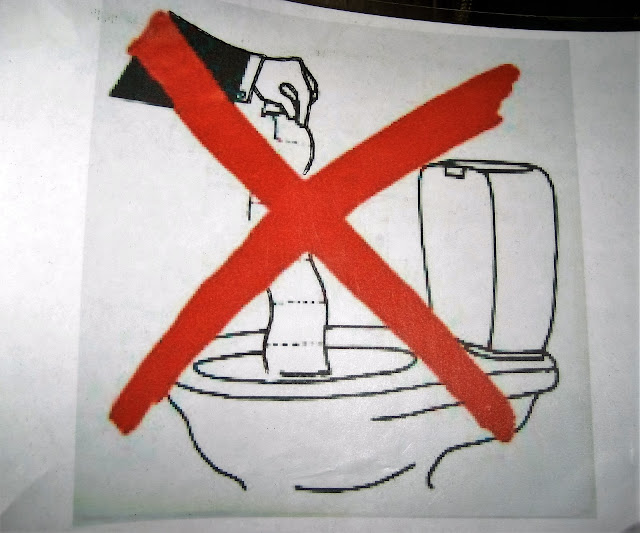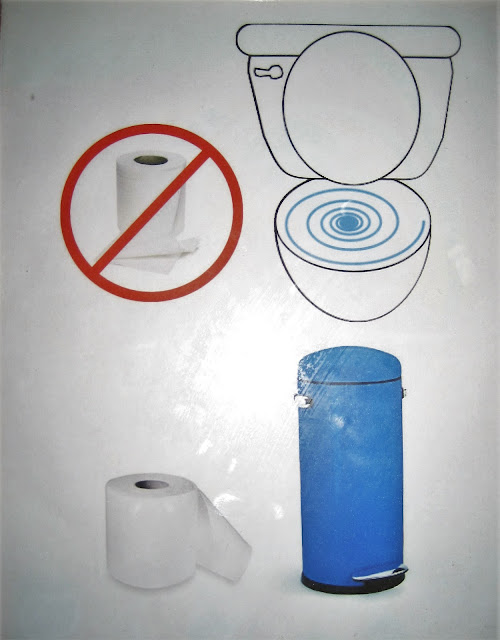 |
| User-friendly toilet instructions. Antigua, Guatemala. April 2016. Photo credit: Mzuriana. |
Definitions: Adherence versus compliance
From a 2019 article in Medscape:
"Noncompliance Versus Nonadherence
".... there is a difference between the two terms. ....
"Generally, 'noncompliance' describes patients who deliberately refuse to follow a treatment plan.
"'Nonadherence' is the behavior in which a patient unintentionally fails to follow a plan.
"Although the resulting behavior might be the same (e.g., unfilled prescriptions, missed appointments), the causes can be very different.
A noncompliant patient could ignore a plan for several reasons, whereas a nonadherent patient might intend to follow physician orders, but be unable to do so. ..."
It is self-serving for providers to default to patient "noncompliance"
It's expedient for healthcare suppliers and insurers** to blame their patients or end users for not following their prescriptions/instructions for:
- Medication
- Equipment
- Exercise routines
- Diet
**Includes researchers, pharma/device developers and designers, process developers and technical writers, administrative and regulatory bodies that oversee approval of products, those who prescribe the meds, equipment, processes, etc. - In short, every entity in the chain that leads to the end user.
In the case of Medicare, patients are financially penalized for not following instructions for things such as CPAP machines and their accoutrement, as Medicare will not pay for the equipment cost unless there is documentation showing the patient is using same.
On the surface, Medicare's punishment follows a logical "if this, then that" algorithm.
But the blame-the-patient model ignores certain realities of working with a cohort of patients who are in the Third or Fourth Ages.
As groups, each of these two Ages is much more likely to live with a constellation of common compliance barriers, including those related to memory or cognition, than patients who are under age 65.
So, for the nonadherence definition, I would change it thusly:
"Nonadherence is the behavior in which a patient unintentionally fails to follow a plan or is unable to consistently follow a plan because adherence requires a certain level of:
- Visual acuity (e.g. to read instructions, liquid measurement levels);
- Motor strength (e.g. to handle or carry DME or the parts thereof);
- Finger and hand dexterity (e.g. to apply eye drops, open latches and lids);
- Time management or impulse control (e.g. to prioritize the timing of doses over the calls of hunger/thirst, such as for meds that must be taken 30 minutes before or after eating);
- Financial resources to implement the plan; or
- The ease and speed with which they can access technical support to answer questions or troubleshoot problems ...
.... you get the idea.
Some thoughts on adherence and compliance in these articles:
- 2018: Medication Adherence: The Elephant in the Room (Source: US Pharmacist)
- Circa 2014 or later: Understanding Factors Influencing Patient Compliance (Source: Care Excellence Management)
But even these articles focus almost all of their attention on how to influence the user.
It is time for the healthcare suppliers and insurers to feel the spotlight's heat
There seems to be scant attention on those who:
- Develop the products,
- Design the products and their packaging,
- Develop the usage protocols and treatment processes, etc.
If low adherence to a treatment is common, then a spotlight should shine on the provider (developer, designer, manufacturer, supplier or prescriber) first, and not the patient.
Note: By "products," I mean:
- Equipment
- Medications and delivery methods of same (e.g. eye drops, ointments, special timing of medication consumption)
- Prescribed actions, such as exercises designed for strength-building, range of motion, motor skills, etc.
The USAID story
The focus on the end users instead of the product providers (et al) reminds me of a story that an Ethiopian university instructor told me in the mid-80s:
In Ethiopia, as land was handed down to sons by their fathers, their descendants - subsistence farmers - owned smaller and smaller pieces of land as it was divvied up with their brothers. The plots of land were becoming too small to support cattle, the traditional livestock of choice.
Some smart people from the US, perhaps with USAID, had a great idea:
Encourage the subsistence farmers to switch from cows to goats. The goats provide meat and milk like cows, but take up less space and consume fewer resources.
Upon hearing this story, I said, "Hey, that is a great idea. Creative!"
The Ethiopian professor said:
"No, it's forcing the farmers to do all the changing.
The oligarchy doesn't have to change anything.
They keep their wealth and vast properties.
What needs to happen is land reform."
What needs to happen is .....
.... pressure to remove adherence barriers at the front- and back-ends instead of more pressure at the user end.
 |
| User-friendly toilet instructions. Antigua, Guatemala. April 2016. Photo credit: Mzuriana. |
No comments:
Post a Comment